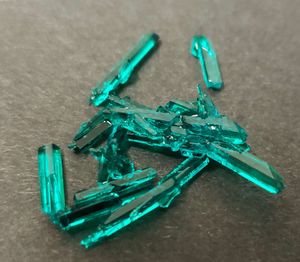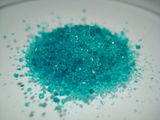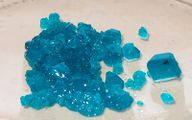Nickel(II) sulfate
 |
This article is a stub. Please help Sciencemadness Wiki by expanding it, adding pictures, and improving existing text.
|
 Some really nice and long NiSO4·6 H2O crystals
| |
| Names | |
|---|---|
| IUPAC name
Nickel(II) sulfate
| |
| Systematic IUPAC name
Nickel(II) sulfate | |
| Other names
Niccolum Sulfuricum
Nickelous sulfate Nickel sulphate Morenosite Retgersite | |
| Properties | |
| NiSO4 (anhydrous) NiSO4·6 H2O (hexahydrate) NiSO4·7 H2O (heptahydrate) | |
| Molar mass | 154.75 g/mol (anhydrous) 262.85 g/mol (hexahydrate) 280.86 g/mol (heptahydrate) |
| Appearance | Yellow solid (anhydride) Blue crystals (hexahydrate) Blue-green crystals (heptahydrate) |
| Odor | Odorless |
| Density | 4.01 g/cm3 (anhydrous) 2.07 g/cm3 (hexahydrate) 1.948 g/cm3 (heptahydrate) |
| Melting point | 100 °C (127 °F; 326 K) (anhydrous) 53 °C (127 °F; 326 K) (hexahydrate, decomposes) |
| Boiling point | 840 °C (1,540 °F; 1,110 K) (anhydrous, decomposes) |
| heptahydrate 65 g/100 ml (20 °C) 77.5 g/100 ml (30 °C) | |
| Solubility | anhydrous Insoluble in acetone, diethyl ether, ethanol hexahydrate Insoluble in ammonia, diethyl ether, ethanol heptahydrate Soluble in ethanol, methanol Insoluble in acetone, diethyl ether, ethyl acetate |
| Acidity (pKa) | 4.5 (hexahydrate) |
| Hazards | |
| Safety data sheet | Sigma-Aldrich (anhydrous) Sigma-Aldrich (hexahydrate) Sigma-Aldrich (heptahydrate) |
| Flash point | Non-flammable |
| Related compounds | |
| Related compounds
|
Nickel(II) chloride Nickel(II) nitrate |
| Except where otherwise noted, data are given for materials in their standard state (at 25 °C [77 °F], 100 kPa). | |
| Infobox references | |
Nickel(II) sulfate is inorganic salt of nickel with formula NiSO4. Nickel sulfate has many forms, anhydride, hexahydrate and heptahydrate. In nature occurs as rare mineral retgersite (hexahydrate) or morenosite (heptahydrate).
Contents
Properties
Chemical
Addition of ammonium sulfate to concentrated aqueous solutions of nickel sulfate precipitates Ni(NH4)2(SO4)2·6H2O. This blue-coloured solid is analogous to Mohr's salt, Fe(NH4)2(SO4)2·6H2O.
Reaction nickel sulfate with sodium hydroxide or any other alkali metal hydroxide yields nickel(II) hydroxide:
- NiSO4 + 2 NaOH → Ni(OH)2 + Na2SO4
Physical
Nickel sulfate is a yellow, green or blue colored, crystalline inorganic compound that produces toxic gases upon heating. Nickel sulfate is used in electroplating and as a chemical intermediate to produce other nickel compounds.
Anhydrous nickel sulfate is a yellow-green crystalline solid. Nickel sulfate can also be obtained as a hexahydrate which is blue to emerald green, and as a heptahydrate (NiSO4·7H2O), which is green. Samples can contain variable quantities of water, depending on their previous exposure to moisture or conditions. All forms of nickel sulfate, anhydrous or hydrated are mildly toxic and are carcinogenic. All forms of nickel sulfate, anhydrous or hydrated are paramagnetic.
Availability
Nickel(II) sulfate is sold by many chemical suppliers.
Preparation
Nickel sulfate can be made by reacting nickel(II) oxide or nickel(II) hydroxide powder with sulfuric acid. The product is purified by recrystallization from concentrated solution.
- NiO + H2SO4 → NiSO4 + H2O
- Ni(OH)2 + H2SO4 → NiSO4 + 2 H2O
A possible route to obtain nickel(II) sulfate, in case sulfuric acid is not available, is to react nickel(II) chloride with sodium sulfate.
- NiCl2 + Na2SO4 → NiSO4 + 2 NaCl
As the solubility of sodium chloride is half than that of NiSO4 at room temperature, it's possible to remove the NaCl from the solution by concentrating it until it precipitates out of the solution. The nickel(II) sulfate is then recrystallized out of the solution. Further recrystallization(s) may be required to eliminate all the leftover Na ions.
Another possible route to nickel(II) sulfate without using sulfuric acid involves the reaction of nickel(II) perchlorate with potassium sulfate. The KClO4 precipitate is filtered off while the NiSO4 is recrystallized from the leftover solution.
- Ni(ClO4)2 + K2SO4 → NiSO4 + 2 KClO4
Anhydrous nickel(II) sulfate is produced by heating the hydrates above 330 °C.
Projects
- Growing crystals
- Nickel plating
- Make nickel carbonate
- Make nickel coordination complexes
Handling
Safety
Exposure to this substance can cause severe dermatitis, skin and asthma-like allergies and affects the lungs, kidneys, gastrointestinal tract and neurological system. Nickel sulfate is a known carcinogen and is associated with an increased risk of developing lung and nasal cancers.
Storage
Nickel(II) sulfate is best stored in closed bottles.
Disposal
Nickel(II) sulfate should be reduced to an insoluble form and taken to disposal centers. The primary hazard is the threat to the environment. Immediate steps should be taken to limit its spread to the environment.

